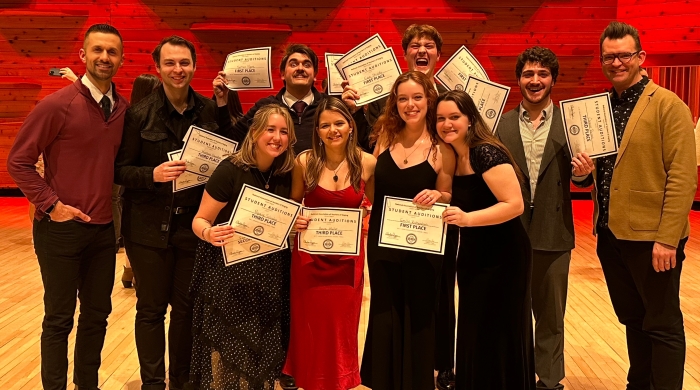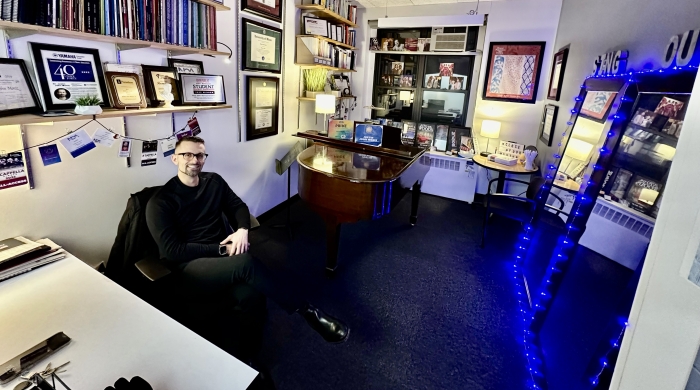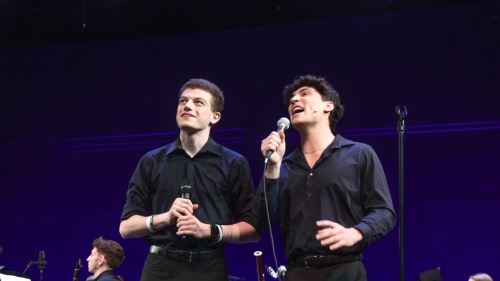More than 70 students and a team of faculty advisors have worked for months on the comic opera production opening April 11.
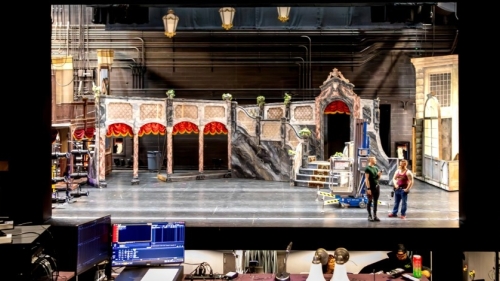
Technicians prepare to focus the lights on the Paulson Center's Cantor Theatre stage, which will host a production of Die Fledermaus. Photo by Tracey Friedman/NYU.
In the 1874 comic opera Die Fledermaus, mistaken identities and a misjudged practical joke are resolved during a lavish New Year’s Eve party, where party-goers flirt, champagne flows, and everyone ends up in jail.
There’s little that’s serious in the plot of the Johann Strauss operetta, but presenting its full-on frivolity can be a heavy lift. For months this semester, more than 70 undergraduate and graduate singers, musicians, and technicians in NYU Steinhardt’s Music and Performing Arts Professions department have been working on this ambitious production, one of the most elaborate the department has ever attempted.
See Die Fledermaus at the Iris Cantor Theatre
Get tickets for April 11, 8 p.m. Get tickets for April 12, 3 p.m. Get tickets for April 12, 8 p.m. Get tickets for April 13, 3 p.m.
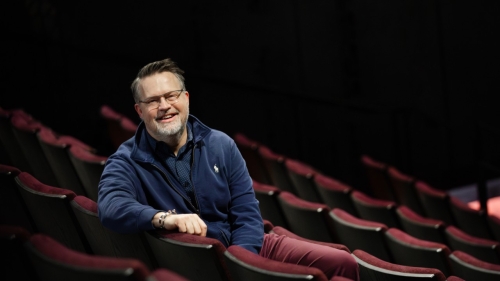
Steinhardt's A. Scott Parry directs the production, with a book he adapted and set in Gilded Age New York City. Photo by Jonathan King/NYU.
Steinhardt’s Die Fledermaus will be performed four times between April 11 and 13 in the Iris Cantor Theatre in the John A. Paulson Center. Adjunct Faculty in Vocal Performance A. Scott Parry directs, using a script he adapted that moves the setting from Vienna to New York City. Joshua Rosenblum, adjunct faculty in Screen Scoring, is the music director. Rented scenery and costumes from professional opera companies create its Gilded Age grandeur and showcase the talents of the student artists.
NYU News spoke with Parry about the logistics of coordinating two casts, a full orchestra, and technical crew as the group prepared to move from the rehearsal room to the stage. He also spoke about the educational value of live performance and made a case for opera’s continued relevance.
Why did you decide to adapt the opera’s libretto to English and set it in New York City?
It was originally a libretto that was written in French, then translated into German for Strauss to compose for the Viennese public. It's meant to be a period piece, and you can hear that in the "old-fashioned" waltz music that pervades it. So I wondered, how can this resonate best for our audience here and now? This requires one to lean into the vernacular of a specific time and place where this sort of music can make sense. I set it in New York City, at the turn of the 20th century at the Waldorf-Astoria, to give it a locally specific context that still has a kind of "waltz" perfume around it. The piece is very tongue-in-cheek, overtly comic and effervescent. There’s a lot of champagne, and partying abounds. The cast has been researching the period by watching HBO's The Gilded Age. That’s the general atmosphere here—an elevated high-society group having fancy parties and celebrating themselves and their forward-looking modernity.
Describe the educational value of participating in this splashy production. How is it different from classroom and voice studio settings?
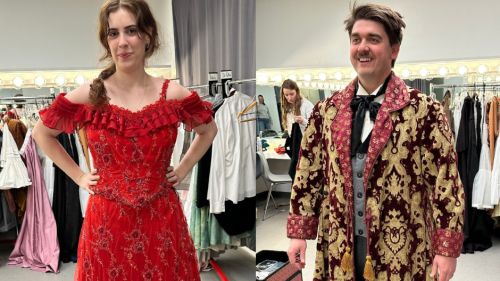
Left: Grace Collins is fitted with her Rosalind costume. Right: Nathan Myers, who plays Gabriel, tries on his suit and robe. Photos by Michelle E. Humphrey.
Students are required to audition and to participate in some kind of production over the course of their performance degree studies. They are not getting academic credit for the show per se, but they are exposed to the experience of the full process, the building of it bit by bit, through each of the individual elements. By performing onstage or being part of the tech crew, they learn how opera functions, how it works from the inside. It’s the practicum of their academic work, their boots-on-the-ground moment. It’s imperative for students to have this kind of hands-on experience. Studying is essential—you are diligently learning the craft. But it’s not just the training of the voice or learning theatre history or taking acting class. You have to learn to fully communicate with an audience, and the only way to do that is to actually be onstage, under the lights, projecting over an orchestra, with a whole mess of people sitting there in front of you. That’s ultimately what it’s all about. That moment in the spotlight in front of an audience who is wanting to connect to the character you’re portraying. This is where the rubber meets the road.
You describe the preparation in layers. Can you walk us through the rehearsal process?
We invest about six months on a production like this. After auditions and casting, we distribute the script and score for everyone to work on individually. We first come together and sing and read through the entire piece, making notes as to what everyone brings in terms of their own research and preparation, and we have musical rehearsals to give unity to all the musical aspects. Next, we have staging rehearsals, with the music director and a rehearsal pianist rather than the orchestra, where we define characters and relationships and how people move and interact. The orchestra rehearses on its own with the conductor. Then we run the whole piece through with note sessions for both music and staging.
Then we have orchestra rehearsals for the music director to coordinate with the performers onstage and the musicians in the pit to determine how everything will be phrased and what tempos will be taken. Outside the rehearsal room, we have design meetings, costume and wig fittings, and lighting instruments getting hung, focused, and cued. After the set arrives and is loaded into the theatre, we rehearse onstage with the actual furniture and props and all the technical elements, and then add costumes and the orchestra for what we call final dress rehearsals for each of the casts. It’s everything all together all at once.
You are performing in the Iris Cantor Theatre, the university’s new state-of-the-art venue. How does this enhance student experience?

A technician stands on the stage to establish the lighting of the stage for Die Fledermaus. Photo by Tracey Friedman/NYU.
Having a modern and fully functional performance space is a wonderful asset of the Steinhardt vocal performance program. It allows us to take advantage of all the production elements that the students will be exposed to in the “real world,” and thus they will be prepared for whatever might happen in their eventual careers.
Additionally, it makes for an enjoyable experience for the audience who comes in to engage with our students in performance. It’s a beautiful venue and one that we are very lucky to have for this production.
Some people might consider opera too old-fashioned or phony to be taken seriously. What is your case for its importance?
Opera is essentially all of the arts combined into one. You are taking a piece of theatre and turning it up to an 11. It incorporates multiple aspects of visual design, vocal music, acting, dance, dialogue, orchestral music—everything one can imagine happening in a theatre. The environment can certainly be large, but the central struggle is to not let the core purpose get lost within all the elements, not to miss the proverbial forest for the trees. You have to make sure you are representing actual human beings having a relatable experience so that the audience can connect that experience to their own lives.
In opera, we are essentially purveyors of empathic exchange. We are giving the audience all the feels, and they in turn are giving it back to us. They are hopefully finding an implicit understanding of people they don’t know living lives onstage that they don't themselves live and are cathartically feeling what we are showing them our characters feel. We connect emotionally through the music and intellectually through the words. In the end, we are all, audience and performers alike, stewing in the vibes together.
Press Contact
(212) 998-6829
Related Articles
Top Honors for Vocal Performance Students in NATS Competition
Eight NYU Vocal Performance students competed in the National Association of Teachers of Singing (NATS) Eastern Region Student Auditions held on March 21-23, 2025. All eight NYU students earned top honors in their divisions.
Moniz named 2025 Ellen Faull Master Teacher by NATS
Dr. Justin Moniz was selected as a 2025 master teacher for the high profile mentoring event, the NATS Intern Program, an intense ten day professional development event.
Meet NYU Steinhardt Costume Supervisor Michelle Humphrey
Michelle Humphrey discusses her job as a costume designer for NYU Steinhardt Music and Performing Arts Professions. "This is a field where creativity and skill will take you far, but passion and persistence will take you even further."
Related Programs
Related Department
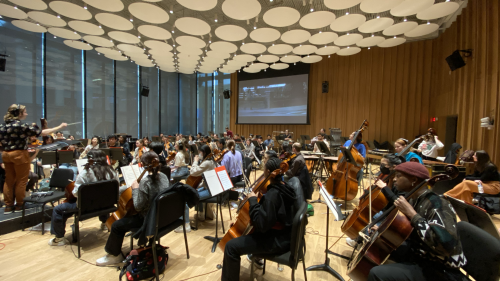
Music and Performing Arts Professions
35 W. 4th Street, 2nd Floor
New York, NY 10012
212-998-5424
mpap@nyu.edu

